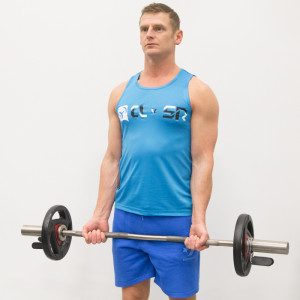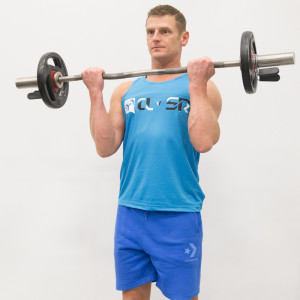EZ Bar Cheat Curl
Starting position:
- Grasp the EZ bar with a closed, slightly pronated grip (palms angled inward), to conform to the outer handles.
- Extend elbows, resting the bar or barbell on the front of thigh.
- Stand up straight with feet shoulder width apart, keeping a slight bend in the knees.
- Keep upper arms tucked against torso and perpendicular to the floor.
Upward movement/concentric phase:
- Lean torso slightly forward while bar is still resting on the front of the thighs.
- Begin to flex the elbows forcefully as you shift your torso backward in a quick manner.
- This controlled swinging motion of the torso should produce enough momentum to aid in approximately half of the biceps curl’s range of motion. The remaining half will rely predominantly on the contraction of the biceps.
- Flex the elbows until the bar is 4 to 6 inches away from the front of shoulder(s).
- Return torso to starting position, standing up straight and upper arms tucked against side of torso.
- Keep wrists straight throughout the exercise.
Downward movement/eccentric phase:
- Slowly allow the elbows to extend back to the starting position.
- Keep standing straight, only the elbow joint is to be moving as it extends.
Exercise Data
FAQ'S & FACTS ABOUT EZ Bar Cheat Curl
What Is A Biceps EZ-Bar Cheat Curl?
The cheating EZ bar biceps curl is variation of the standing biceps curl. It involves the primary elbow flexors, the brachialis and biceps brachii with added momentum from controlled torso flexion and extension. This exercise is performed with an EZ bar. The EZ bar provides an alternative to performing cheat curls with a barbell, dumbbells or cables. The concentric portion of the lift is elbow flexion as the torso is extending back to starting position. The concentric portion involves the lifting of the weight. The eccentric portion is elbow extension, which involves the descent of the weight. The eccentric portion also consists of minimal torso flexion to produce the momentum.
The purpose of the cheating EZ bar curl is to strengthen the biceps with the aid of momentum when lifting heavier weight and/or in a fatigued state. The cheating curl allows a lifter to take advantage of controlling the eccentric contraction without the aid of momentum. This allows a lifter to reap the gains acquired from controlled eccentric contractions without fatiguing from the concentric portion of the lift. This lift also promotes hypertrophy (increases in size) of the biceps.
Why Do Biceps EZ-Bar Cheat Curls?
The cheating EZ bar biceps curl strengthens and increases the size of the biceps brachii, brachialis and brachioradialis.
The cheating EZ bar biceps curl allows for additional repetitions to be performed at the end of traditional set (where torso movement is not involved). Once fatigue is reached, the lifter may implement “cheat reps” to increase repetition volume, targeting the latter half of lift (the concentric portion) with full emphasis of controlling the descent of the bar (the eccentric portion of the lift).
For example, a lifter may start their set with traditional lifting technique, executing 5 to 7 biceps curl repetitions to failure. Upon reaching failure/fatigue, the lifter may perform 3 to 4 cheat reps. This will increase the number of repetitions they perform and will elicit extensive muscle damage. With proper recovery afterward, this type of exercise-induced muscle damage may contribute to gains in strength and hypertrophy.
The EZ bar is an alternative to utilizing a barbell. With an EZ bar, the grip is less supinated with palms facing inward. Elbow flexion performed in this position, with rotation of the forearms slightly inward, activates the long head of the biceps brachii. In addition, using an EZ bar places less stress on the wrists.
Anatomy Of A Biceps EZ-Bar Cheat Curl
The biceps brachii is located on the front of the arm, originating at the shoulder and inserting in the elbow joint. It consists of two heads, the long head (outer biceps) and the short head (inner biceps). The long head tendon helps stabilize the shoulder joint and its origin is located at the tubercle and lip of the glenoid cavity of the scapula (shoulder blade). The short head origin is located at the coracoid process of the scapula. The long and short head unite as the muscle bellies run down the front of the arm. Both heads merge, sharing insertion into the radial tuberosity of the elbow joint.
The biceps brachii flexes the elbow joint and supinates the forearm. Supination refers to the simultaneous rotation of the wrist and elbow as the palm of your hand faces upward. Both heads of the biceps flex the elbow joint together, however, the EZ bar grip is less supinated, eliciting greater activation of the long head of the biceps brachii.
The brachialis lies underneath the biceps brachii, originating at the front of the lower end of the humerus bone. Its insertion is located at the coronoid process of the ulna at the elbow joint. The brachialis is a primary elbow flexor.
The brachioradialis aids the biceps brachii and brachialis, helping stabilize the elbow joint during biceps curls.
Although their contribution is minimal, forearm muscles, palmaris longus, flexor carpi radialis, and pronator teres contribute as weak flexors of the elbow joint.
The subscapularis works in conjunction with the other three rotator cuff muscles to stabilize the shoulder joint during this exercise.
The erector spinae muscles of the back help produce the momentum as the torso bends forward and powerfully extends. The erector spinae muscle group consists of the iliocostalis, longissimus, and spinalis.
Variations Of A Biceps EZ-Bar Cheat Curl
Wide grip, narrow grip, reverse curl.
How To Improve Your Biceps EZ-Bar Cheat Curl
The cheating curl (also known as “cheat reps”) is implemented in a training program to increase strength and hypertrophy of the biceps.
It allows a lifter to increase repetition volume, “knocking out” a few more reps at the end of a set when fatigue is setting in. It is important to incorporate “cheat reps” at the end of set, as their purpose is to provide momentum to aid the lifter nearing fatigue.
Emphasis on eccentric contractions, prolonging the eccentric portion of the contraction, allows the lifter to reap the benefits of the cheat rep. Strategizing this type of lift at the end of a set will allow a lifter to gradually increase their biceps strength and be able to lift more as their biceps adapt to the resistance.
It’s important to note that your repetition and set volume will depend on your goals (e.g. strength, hypertrophy, muscular endurance). It is also important to allow adequate recovery days in between biceps training to allow muscles to repair.
Common Mistakes When Doing Biceps EZ-Bar Cheat Curls
An experienced lifter should only perform this type of lift. If the torso swinging is too exaggerated, injury may occur.
Flexing and/or extending the wrists during elbow flexion. The wrists are to remain straight throughout the full range of motion.
Standing on an unstable surface or with an unstable stance can also compromise technique. Your feet are your foundation and should be in a position of stability. If you are looking to maximize the contraction of your biceps, ensure that your feet are shoulder width apart with a slight bend in the knees. Stand on a flat surface. Standing with one foot in front of the other during a cheating biceps curl can also compromise balance and decrease the potential for optimal muscle contraction.
Injuries Or Ailments & Their Effects Regarding Biceps EZ-Bar Cheat Curls
If proper technique is not adhered to (e.g. proper swinging of the torso, dropping the weight quickly instead of controlling the descent on the eccentric portion of the lift), the likelihood of back, wrist and/or biceps injury increases.
Although rare, biceps tendon rupture may occur if warm-up is not sufficient and/or if intensity (load) is increased inappropriately.
If proper recovery is not implemented between training days for optimal muscle repair of the biceps, the biceps tendon becomes inflamed. Without proper rest and treatment, the inflammation remains and results in biceps tendonitis.
Impingement syndrome and rotator cuff injuries, in general, are commonly associated with biceps tendonitis/biceps tendinosis. Therefore, it’s best to avoid bicep exercises when addressing impingement syndrome/rotator cuff injury unless advised by a physical therapist.





